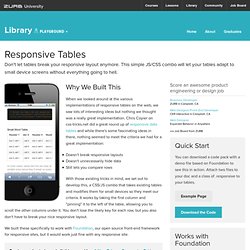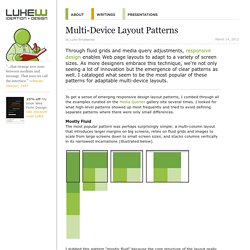

Flexible, Mobile-First Layouts with CSS3. Some experts are projecting mobile devices to become the dominant medium for web browsing within five years, overtaking browsing on desktop computers.

Regardless of how accurate this projection turns out to be, it is clear that formatting websites for mobile-friendly viewing needs to become a staple of web design and development. There are many ways to accomplish this, of course. However, CSS3 provides a fairly rich toolset for mobile-friendly formatting, relying on the client's browser capabilities instead of back-end templating. Step 1. Think Ahead There are a few issues that should be thought about before diving right into styling a layout. Mobile Web Browsing First, what should one keep in minds when designing for mobile browsers? Limit HTTP requests: data transfer over 3G can be quite taxing. How to Build a Simple Mobile Website with CSS3. In this article we're going to look at a variety of options for building simple mobile websites with CSS3. Note that these techniques won't work with all phones but if you only need a mobile site for a few devices, these tips could to the trick.
Before we get started, be aware that due to the restricted viewing space, a mobile website is generally one column of data, with the exception of simple tables and small buttons side by side. It's not a good idea to try and cram a lot of data into that space. If you use PDF documents as part of your layout, I recommend reformatting them into a single column of data, no more than 480pixels wides. If you don't despite using a PDF reading app, it may be hard to see on a mobile device. Gallery of Responsive Sites. Responsive from ZURB. Foundation: The Most Advanced Responsive Front-end Framework from ZURB. Off Canvas Layouts CSS - Foundation 3 - ZURB Playground - ZURB.com.
Off Canvas What Now?

If you've used Facebook's iPhone app (or Path, or any number of apps that now follow this convention) then you've seen an off canvas panel in a native app. You hit a button and a panel slides in from the left (or depending on how you look at it, the main panel slides out of the way). Pragmatic responsive design. Responsive Tables with CSS/JS - Foundation 3 - ZURB Playground - ZURB.com. Why We Built This When we looked around at the various implementations of responsive tables on the web, we saw lots of interesting ideas but nothing we thought was a really great implementation.

Chris Coyier on css-tricks.net did a great round up of responsive data tables and while there's some fascinating ideas in there, nothing seemed to meet the criteria we had for a great implementation: Doesn't break responsive layouts Doesn't unnecessarily hide data Still lets you compare rows With those existing tricks in mind, we set out to develop this, a CSS/JS combo that takes existing tables and modifies them for small devices so they meet our criteria. It works by taking the first column and "pinning" it to the left of the table, allowing you to scroll the other columns under it. Multi-Device Layout Patterns. Through fluid grids and media query adjustments, responsive design enables Web page layouts to adapt to a variety of screen sizes.

As more designers embrace this technique, we're not only seeing a lot of innovation but the emergence of clear patterns as well. I cataloged what seem to be the most popular of these patterns for adaptable multi-device layouts. To get a sense of emerging responsive design layout patterns, I combed through all the examples curated on the Media Queries gallery site several times. I looked for what high-level patterns showed up most frequently and tried to avoid defining separate patterns where there were only small differences.
Mostly Fluid The most popular pattern was perhaps surprisingly simple: a multi-column layout that introduces larger margins on big screens, relies on fluid grids and images to scale from large screens down to small screen sizes, and stacks columns vertically in its narrowest incarnations (illustrated below). Column Drop. The Responsive Wireframe Boilerplate. Wirefy was created as a tool to help web designers and developers create fast, manageable wireframes.

It helps to speed up the journey between sketches and final deliverables. Like the web, it is in constant iteration. Creating Responsive Web Design by Chris Converse. Web Design How-To: Get Started with Responsive Web Design. With the introduction and proliferation of smart phones and tablets, the way websites are designed is changing.

As more websites are visited by users of tablets and phones, your design has to accommodate a myriad of screen sizes. In more traditional web design workflows, designers and developers target a specific screen width, then let smaller devices invoke pinch-and-zoom actions to change the size of the page and in so doing allow visitors to explore your page more extensively. While the capability to pinch-and-zoom to expose more content is a great feature of modern mobile devices, your content will benefit greatly if it can adapt to multiple screen sizes. This can, however, be a daunting task when you consider the growing number of devices available.
This is where responsive design comes in.